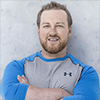A new course is available at Weik University on building massive shoulders. Those interested in sitting through an easy course, no need to look any further because class has just begun. Everyone is guaranteed an "A" for the course as long as you sit through the course and pay attention (you can take notes if you wish). From there, all you have to do is take what you learned from the course and utilize it in the gym for massive shoulder gains.
Let's start with the basics of Chapter 1 and then get into more detail later on in the course.
Chapter 1: Anatomy Of The Shoulder
Let's start off by explaining the anatomy of the shoulder. It's not very complicated and not much to it. Once you understand how the shoulder works, you will find it easier to visualize your shoulder workouts.
The shoulder is the most movable joint in the body but is very unstable. The shoulder itself is a ball and socket joint. The ball of the shoulder is the head of the humerus. The socket portion of the shoulder is called the glenoid (where arthritis in the shoulder forms).
On top of the ball and socket is a process called the acromion (where bone spurs can form). Next to the acromion is the acromioclavicular joint, also called the AC Joint (this is a common place for shoulder separations). This ball and socket joint allows for the most range of motion out of all the joints in the body.
The roundness that you see at your shoulder is actually made up of 3 separate muscles or "heads". These heads are the anterior, middle, and posterior deltoids. The deltoid is a pinnate muscle, which is where the muscle with fascicles attaches obliquely to its tendon. This allows better force production and stabilization but you lose flexibility.
Chapter 2: Different Parts Of The Shoulder
Anterior Deltoid
The anterior deltoid originates on the clavicle and inserts onto the deltoid tuberosity of the humerus. The main job of the anterior deltoid is shoulder abduction when the shoulder is externally rotated, but it also assists with transverse flexion but it is not a strong movement for this part of the deltoid.
Middle Deltoid
The middle deltoid originates on the acromion and inserts onto the deltoid tuberosity of the humerus. The purpose of the middle deltoid is shoulder abduction when the shoulder is internally rotated and also assists in shoulder transverse abduction.
Posterior Deltoid
The posterior deltoid originates on the spine of the scapula and inserts onto the deltoid tuberosity of the humerus. The posterior deltoid aids in shoulder extension, external rotation, transverse abduction and also transverse extension.
Rotator Cuff
Another key component of the shoulder is the rotator cuff. This is a place for common injuries to take place due to overuse or underuse. The rotator cuff is made up of four muscles; the teres minor, infraspinatus, supraspinatus, and subscapularis. These four muscles are what aid in all overhead and rotational movements at the shoulder.
Chapter 3: Different Shoulder Exercises
- Barbell Front Raises
- Dumbbell Front Raises
- Cable Front Raises
- Dumbbell Lateral Raises
- Cable Lateral Raises
- Bent-Over Lateral Raises
- Cable Rear Delt Reverse Fly
- Arnold Presses
- Military Presses
- Barbell Shoulder Press
- Dumbbell Shoulder Press
- Barbell Upright Rows
- Dumbbell Upright Rows
- Cable Upright Rows
Chapter 4: Mass Building Shoulder Workouts
Workout 1
- Dumbbell Front Raises: 3x8-12
- Dumbbell Side Lateral Raises: 3x8-12
- Bent-Over Lateral Raises: 3x8-12
- Dumbbell Shoulder Press: 3x8-12
 Click Here For A Printable Log Of Workout #1.
Click Here For A Printable Log Of Workout #1.
Workout 2
- Barbell Front Raises: 3x8-12
- Cable Lateral Raises: 3x8-12
- Cable Rear-Delt Reverse Fly: 3x8-12
- Military Presses: 3x8-12
 Click Here For A Printable Log Of Workout #2.
Click Here For A Printable Log Of Workout #2.
Workout 3
- Cable Front Raises: 3x8-12
- Dumbbell Side Lateral Raises: 3x8-12
- Bent-Over Lateral Raises: 3x8-12
- Arnold Presses: 3x8-12
 Click Here For A Printable Log Of Workout #3.
Click Here For A Printable Log Of Workout #3.
Workout 4
- Dumbbell Front Raises: 3x8-12
- Cable Lateral Raises: 3x8-12
- Cable Rear-Delt Reverse Fly: 3x8-12
- Barbell Shoulder Press: 3x8-12
 Click Here For A Printable Log Of Workout #4.
Click Here For A Printable Log Of Workout #4.
Workout 5
- Cable Front Raises: 3x8-12
- Cable Side Lateral Raises: 3x8-12
- Cable Rear-Delt Reverse Fly: 3x8-12
- Arnold Presses: 3x8-12
 Click Here For A Printable Log Of Workout #5.
Click Here For A Printable Log Of Workout #5.
Course Conclusion
When it comes down to it you want to focus on the mind-muscle connection. You should really feel each rep and feel the muscle working. If you don't feel an exercise in your shoulders, then you are probably doing it wrong or are using a weight that you can't handle and are using more than just your shoulders.
Most of all have fun with your workouts. If you aren't having fun, then what's the point? Utilize what you learned in this course and see where it takes you. Good luck and see you at graduation!
Note: Weik University is not a real college and therefore this is not a real course. The materials found in this article are those of the author and will not give you college credits (sorry)
